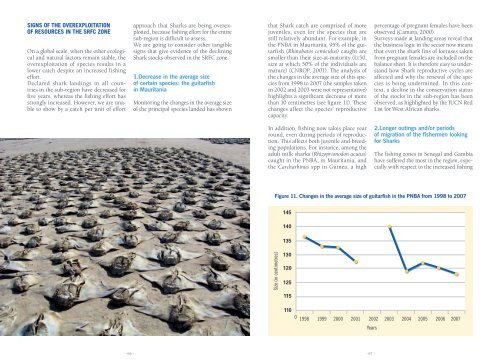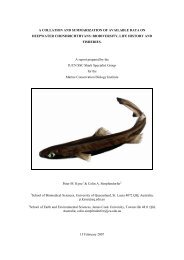30 Years of shark fishing in west africa - Shark Specialist Group
30 Years of shark fishing in west africa - Shark Specialist Group
30 Years of shark fishing in west africa - Shark Specialist Group
Create successful ePaper yourself
Turn your PDF publications into a flip-book with our unique Google optimized e-Paper software.
Signs <strong>of</strong> the overexploitation<br />
<strong>of</strong> resources <strong>in</strong> the SRFC zone<br />
On a global scale, when the other ecological<br />
and natural factors rema<strong>in</strong> stable, the<br />
overexploitation <strong>of</strong> species results <strong>in</strong> a<br />
lower catch despite an <strong>in</strong>creased <strong>fish<strong>in</strong>g</strong><br />
effort.<br />
Declared <strong>shark</strong> land<strong>in</strong>gs <strong>in</strong> all countries<br />
<strong>in</strong> the sub-region have decreased for<br />
five years, whereas the <strong>fish<strong>in</strong>g</strong> effort has<br />
strongly <strong>in</strong>creased. However, we are unable<br />
to show by a catch per unit <strong>of</strong> effort<br />
approach that <strong>Shark</strong>s are be<strong>in</strong>g overexploited,<br />
because <strong>fish<strong>in</strong>g</strong> effort for the entire<br />
sub-region is difficult to assess.<br />
We are go<strong>in</strong>g to consider other tangible<br />
signs that give evidence <strong>of</strong> the decl<strong>in</strong><strong>in</strong>g<br />
<strong>Shark</strong> stocks observed <strong>in</strong> the SRFC zone.<br />
1.Decrease <strong>in</strong> the average size<br />
<strong>of</strong> certa<strong>in</strong> species: the guitarfish<br />
<strong>in</strong> Mauritania<br />
Monitor<strong>in</strong>g the changes <strong>in</strong> the average size<br />
<strong>of</strong> the pr<strong>in</strong>cipal species landed has shown<br />
that <strong>Shark</strong> catch are comprised <strong>of</strong> more<br />
juveniles, even for the species that are<br />
still relatively abundant. For example, <strong>in</strong><br />
the PNBA <strong>in</strong> Mauritania, 95% <strong>of</strong> the guitarfish<br />
(Rh<strong>in</strong>obatos cemiculus) caught are<br />
smaller than their size-at-maturity (Lt50,<br />
size at which 50% <strong>of</strong> the <strong>in</strong>dividuals are<br />
mature) (CNROP, 2001). The analysis <strong>of</strong><br />
the changes <strong>in</strong> the average size <strong>of</strong> this species<br />
from 1998 to 2007 (the samples taken<br />
<strong>in</strong> 2002 and 2003 were not representative)<br />
highlights a significant decrease <strong>of</strong> more<br />
than 10 centimetres (see figure 11). These<br />
changes affect the species’ reproductive<br />
capacity.<br />
percentage <strong>of</strong> pregnant females have been<br />
observed (Camara, 2000).<br />
Surveys made at land<strong>in</strong>g areas reveal that<br />
the bus<strong>in</strong>ess logic <strong>in</strong> the sector now means<br />
that even the <strong>shark</strong> f<strong>in</strong>s <strong>of</strong> foetuses taken<br />
from pregnant females are <strong>in</strong>cluded on the<br />
balance sheet. It is therefore easy to understand<br />
how <strong>Shark</strong> reproductive cycles are<br />
affected and why the renewal <strong>of</strong> the species<br />
is be<strong>in</strong>g underm<strong>in</strong>ed. In this context,<br />
a decl<strong>in</strong>e <strong>in</strong> the conservation status<br />
<strong>of</strong> the stocks <strong>in</strong> the sub-region has been<br />
observed, as highlighted by the IUCN Red<br />
List for West African <strong>shark</strong>s.<br />
In addition, <strong>fish<strong>in</strong>g</strong> now takes place year<br />
round, even dur<strong>in</strong>g periods <strong>of</strong> reproduction.<br />
This affects both juvenile and breed<strong>in</strong>g<br />
populations. For <strong>in</strong>stance, among the<br />
adult milk <strong>shark</strong>s (Rhizoprionodon acutus)<br />
caught <strong>in</strong> the PNBA, <strong>in</strong> Mauritania, and<br />
the Carcharh<strong>in</strong>us spp <strong>in</strong> Gu<strong>in</strong>ea, a high<br />
2.Longer out<strong>in</strong>gs and/or periods<br />
<strong>of</strong> migration <strong>of</strong> the fishermen look<strong>in</strong>g<br />
for <strong>Shark</strong>s<br />
The <strong>fish<strong>in</strong>g</strong> zones <strong>in</strong> Senegal and Gambia<br />
have suffered the most <strong>in</strong> the region, especially<br />
with respect to the <strong>in</strong>creased <strong>fish<strong>in</strong>g</strong><br />
Figure 11. Changes <strong>in</strong> the average size <strong>of</strong> guitarfish <strong>in</strong> the PNBA from 1998 to 2007<br />
145<br />
140<br />
135<br />
Size (<strong>in</strong> centimetres)<br />
1<strong>30</strong><br />
120<br />
125<br />
115<br />
110<br />
0<br />
1998 1999 2000 2001 2002 2003 2004 2005 2006 2007<br />
<strong>Years</strong><br />
- 66 -<br />
- 67 -
















